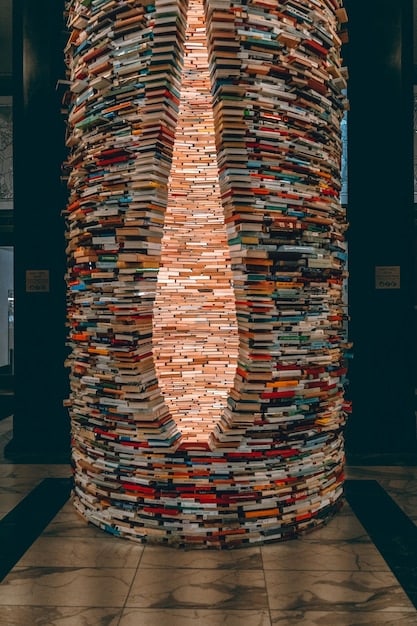Literary Fiction: Narrative Style & Character Development Dissected

Literary fiction distinguishes itself by its profound exploration of the human condition, prioritizing intricate narrative styles and deep character development over plot, often employing sophisticated language and thematic complexity to evoke emotional and intellectual resonance.
Delving into the realm of storytelling, Literary Fiction’s Defining Characteristics: Dissecting Narrative Style and Character Development offers a rich landscape for intellectual and emotional engagement, inviting readers to explore profound human experiences through nuanced prose and intricately crafted characters.
The Essence of Literary Fiction: An Overview
Literary fiction often stands apart from genre fiction by its primary focus on artistic merit and the human experience, rather than adherence to strict plot conventions or commercial appeal. It is a domain where style and substance converge to create resonant, thought-provoking narratives.
Its hallmarks include a deep engagement with themes, a sophisticated narrative voice, and characters that evolve with compelling psychological depth. Unlike many genre works, the journey in literary fiction is often more about internal transformation or the exploration of universal truths than external conflicts or resolutions.
Beyond Plot: Exploring Thematic Richness
While plot is present, in literary fiction, it frequently serves as a framework for deeper thematic exploration. Authors probe complex ideas such as identity, memory, morality, and the nuances of human relationships. This focus ensures that the work transcends simple entertainment to offer lasting insight.
- Universal themes: Addresses experiences and emotions common to humanity.
- Ambiguity: Often leaves room for interpretation, mirroring life’s complexities.
- Social commentary: Provides critical perspectives on societal structures and norms.
The narratives might unfold at a slower pace, allowing readers to fully immerse themselves in the characters’ inner lives and the author’s stylistic choices. This deliberateness is key to its impactful intellectual and emotional resonance, making it a distinct category in the literary landscape.
Narrative Style: Crafting the Voice
The narrative style in literary fiction is paramount; it is the unique voice and technique through which the story is told. This involves deliberate choices regarding point of view, syntax, rhythm, and diction, all contributing to the reader’s immersive experience and deeper understanding of the text.
Authored with meticulous care, the language itself becomes a character, shaping perception and mood. Stylistic devices are employed not for mere embellishment, but to deepen thematic meaning and evoke precise emotional responses. This attention to craft elevates the work beyond simple storytelling to an art form.
The Art of Prose: Language and Imagery
Literary fiction revels in exquisite prose. Sentences are often carefully constructed, with an emphasis on rhythm, alliteration, and evocative imagery. Authors may employ complex sentence structures or deliberate repetition to create specific effects, guiding the reader’s emotional and intellectual journey.
- Figurative language: Metaphors, similes, and symbolism enrich meaning.
- Sensory details: Vivid descriptions appeal to sight, sound, touch, taste, and smell.
- Lyrical qualities: Prose often approaches the beauty and rhythm of poetry.
The choice of words is rarely coincidental; every phrase serves a purpose. This precision allows authors to convey intricate ideas and subtle emotional states, drawing the reader into the narrative’s unique world and fostering a heightened awareness of the story’s underlying messages.

Character Development: Unpacking the Human Psyche
One of the most compelling aspects of literary fiction is its unparalleled commitment to character development. Characters are seldom static; they are complex, flawed, and often undergo significant internal transformations, mirroring the intricacies of real human experience.
Authors delve deep into the psychological landscapes of their characters, exploring their motivations, fears, desires, and moral ambiguities. This granular approach creates a profound sense of authenticity, allowing readers to truly connect with and understand the characters on a profound level, beyond superficial actions or roles.
Internal Monologue and Psychological Depth
To reveal the inner workings of characters, literary fiction frequently employs techniques like internal monologue, stream of consciousness, and psychological introspection. These methods grant readers direct access to characters’ thoughts and feelings, fostering empathy and understanding.
- Complex motivations: Characters are driven by layered and often conflicting desires.
- Moral ambiguity: Protagonists and antagonists alike defy simple categorization as purely ‘good’ or ‘evil’.
- Evolution: Characters often undergo significant internal growth or decline throughout the narrative.
This commitment to psychological realism ensures that the characters resonate long after the book is closed. Their struggles and triumphs become reflections of universal human conditions, prompting readers to reconsider their own lives and perspectives. The journey of a character in literary fiction is often an inward one, defining the core essence of the narrative.
Ambiguity and Open Endings: Embracing Complexity
Literary fiction often shies away from neat, conclusive endings, embracing ambiguity and open interpretations. This deliberate choice challenges readers to engage actively with the text, to ponder unresolved questions, and to draw their own conclusions, much like in real life.
The absence of definitive answers mirrors the inherent uncertainties of the human condition. It suggests that life’s most profound questions seldom have simple solutions. This approach encourages ongoing reflection and discussion, extending the life of the narrative beyond its final page.
The Power of Implied Meaning
Instead of explicit declarations, literary authors often rely on implication and subtlety. Meanings are layered, requiring careful reading and critical thought to fully unpack. Symbolism, irony, and understatement are common tools used to convey intricate ideas without direct exposition.
- Subtext: Unspoken meanings and hidden implications enrich dialogue and interactions.
- Symbolism: Objects, events, or characters represent deeper, abstract ideas.
- Interpretive freedom: Readers are given space to construct their own understanding.
This nuanced approach respects the reader’s intelligence, inviting them into a collaborative process of meaning-making. It transforms reading from a passive activity into an active intellectual pursuit, where the satisfaction comes from discerning deeper truths within the text, even if they remain elusive or open-ended.
The Role of Setting and Atmosphere
In literary fiction, setting is rarely just a backdrop; it often functions as an integral element that shapes characters, influences mood, and contributes to thematic development. The atmosphere created by the detailed environment can be as impactful as the narrative itself.
Authors meticulously craft settings to reflect internal states, societal pressures, or historical contexts. Weather, architecture, and landscape can mirror characters’ emotional journeys or serve as symbolic representations of larger societal issues, adding layers of meaning to the story.
Environment as Character and Symbol
The physical and social environments in literary works frequently take on roles beyond mere location. They can act as forces that oppress or liberate characters, or symbolize abstract concepts like decay, hope, or tradition. This depth of integration enriches the reader’s understanding of the narrative.
- Mirroring emotions: A bleak landscape might reflect a character’s internal despair.
- Symbolic significance: A decaying house could represent a family’s decline.
- Historical context: Setting grounds the story in a specific time, allowing exploration of its societal norms.
The atmospheric details contribute significantly to the overall tone of the work, immersing the reader in the sensory and emotional world of the story. Whether it is the vast emptiness of a desert or the claustrophobic confines of an urban apartment, the setting imbues the narrative with a unique texture and a powerful sense of place, enhancing its thematic resonance.
Literary Fiction vs. Genre Fiction: A Symbiotic Relationship
While frequently presented as distinct categories, literary fiction and genre fiction are not necessarily mutually exclusive. Many works blur the lines, demonstrating that the defining characteristics of literary fiction can enrich and elevate genre narratives, fostering a more complex and nuanced literary landscape.
For instance, a science fiction novel might explore profound philosophical questions with sophisticated prose, or a detective story might prioritize intricate character studies over straightforward plot resolution, thus gaining a ‘literary’ quality. The distinction often lies in intent and emphasis, rather than strict adherence to boundaries.
When Genres Converge: Hybrid Narratives
The literary world increasingly sees a rise in hybrid narratives, where the thematic depth and stylistic finesse of literary fiction merge with the structural conventions and thematic frameworks of various genres. This convergence creates a richer, more diverse reading experience.
- Literary thrillers: Focus on psychological depth and intricate prose within a suspenseful plot.
- Speculative fiction with literary merit: Explores philosophical ideas through fantastical or futuristic settings.
- Historical fiction as social commentary: Uses historical events to examine contemporary social issues.
This cross-pollination benefits both categories. Literary fiction gains new audiences through engaging genre elements, while genre fiction is elevated by a greater emphasis on craft, character, and thematic complexity. Ultimately, this symbiotic relationship helps expand the very definition of what constitutes compelling and meaningful storytelling in the contemporary literary scene.

The Enduring Appeal and Impact
Literary fiction’s defining characteristics contribute to its enduring appeal and profound cultural impact. By prioritizing the human condition, sophisticated narrative styles, and deep character development, it offers more than just stories; it provides reflections on existence, challenges perspectives, and fosters empathy.
Its ability to transcend time and place, through universal themes and finely crafted prose, ensures its continued relevance. Unlike works designed for fleeting trends, literary fiction often aims for timelessness, striving to resonate with generations of readers by exploring questions that remain perennially significant.
Cultivating Empathy and Critical Thought
Engaging with literary fiction is an exercise in empathy and critical thinking. Readers are invited to step into diverse perspectives, grapple with moral dilemmas, and interpret complex narratives, thereby broadening their understanding of themselves and the world around them.
- Emotional resonance: Elicits deep feelings and connections to characters’ experiences.
- Intellectual stimulus: Encourages analysis, interpretation, and philosophical inquiry.
- Cultural insight: Provides windows into different societies, histories, and shared human experiences.
The continuous dialogue between reader and text, fostered by literary fiction’s layered meanings and open-ended nature, makes it a potent tool for personal and intellectual growth. It challenges assumptions, provokes thought, and ultimately, enriches the human spirit, solidifying its irreplaceable position in the vast tapestry of storytelling.
| Key Point | Brief Description |
|---|---|
| 📚 Thematic Depth | Explores profound human experiences beyond simple plotlines. |
| ✍️ Narrative Craft | Emphasis on unique voice, sophisticated language, and style. |
| 🧠 Character Psychology | Deep dive into inner lives, motivations, and transformations. |
| 🤔 Ambiguity | Often features open endings and subtle meanings, inviting interpretation. |
Frequently Asked Questions About Literary Fiction
Literary fiction’s primary goal is to explore the human condition and universal truths through artistic and complex storytelling. It often prioritizes deep character development, sophisticated narrative style, and thematic richness over plot-driven entertainment, aiming for intellectual and emotional resonance with the reader.
Narrative style in literary fiction is typically highly self-aware and distinctive. Authors make deliberate choices in prose, syntax, and voice to shape the reader’s experience, often employing complex sentence structures, rich metaphors, and experimental techniques to convey deeper meanings and emotions.
Character development in literary fiction is characterized by profound psychological depth and internal transformation. Characters are often complex, flawed, and morally ambiguous, undergoing significant personal evolutions. Authors delve into their motivations, fears, and inner consciousness to create authentic and relatable human portraits.
While some literary fiction can be challenging due to its complex themes or experimental styles, “difficult” is subjective. Many works are accessible and engaging, inviting readers to think deeply rather than presenting explicit answers. The perceived difficulty often stems from its emphasis on nuance and open interpretation.
Literary fiction and genre fiction are not mutually exclusive. While genre fiction typically adheres to specific conventions (e.g., sci-fi, fantasy), literary fiction prioritizes artistic merit and human insight. Many contemporary works blend these, with genre narratives adopting literary depth and stylistic sophistication, enriching both categories.
Conclusion
As we’ve explored, literary fiction is a genre defined less by external plot contrivances and more by its profound commitment to the nuances of the human experience. Its distinguishing characteristics—ranging from an intricate narrative style and meticulous prose to deeply developed, psychologically complex characters—invite readers to engage on an intellectual and emotional level that transcends mere entertainment. By embracing ambiguity, thematic depth, and the integral role of setting, literary fiction not only challenges but enriches our understanding of the world and ourselves. It stands as a testament to the enduring power of storytelling as an art form, continually pushing boundaries and offering timeless insights into the tapestry of human existence.





